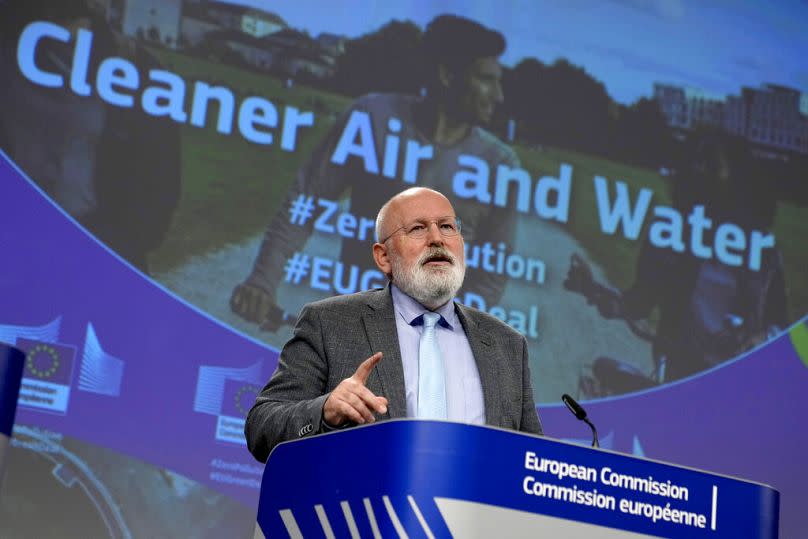The EU’s green transition will need a pro-growth tax policy to succeed

For European policymakers, protecting the planet is not a debate — it’s a legal obligation.
The EU’s green transition — outlined in the European Green Deal and legally enshrined in the European Climate Law — aims to achieve EU climate neutrality by 2050.
But if the EU wants any chance of fulfilling its commitment, then it’s going to need a pro-growth tax policy to incentivise private investment.
Brussels has to create space for productive investments
If there’s one thing we know for certain, it’s that revolutionising an entire continent’s economy is expensive.
It requires “greening” the physical capital stock, building new energy infrastructure, and managing the societal changes associated with shifting market dynamics.
‘Clean energy is moving fast’: Solar set to overtake oil in investments for the first time ever
Why is the EU's green investment label for nuclear and gas so controversial?
And while the total price tag is difficult to pin down, one holistic estimate from McKinsey & Company puts the total transition cost at €28 trillion over 30 years—just under €1tn a year.
By contrast, the European Court of Auditors estimates that EU financial support could help provide over €200 billion per year from 2021 to 2027.

The message is clear: public financing simply cannot cover the gap. It must be filled by private investment.
What can governments do? Brussels can make the system more efficient by completing the Capital Markets Union to mobilise private savings into productive investments.
Protecting strict state aid rules will also limit a subsidy race to the bottom that would otherwise hurt the Single Market.
Full expensing could help
Often, national governments use temporary green tax incentives or public spending programs to guide investment decisions, but these policies come with compliance costs that hamper investment and run the risk of crowding out private investment.
There is, however, a principled, pro-growth tax policy that could help accelerate marginal green investment decisions: full expensing.

Full expensing allows businesses to immediately deduct the full cost of certain investments in new or improved technology, equipment, or buildings.
It incentivises companies to invest more, which, in the long run, raises worker productivity, boosts wages, and creates more jobs.
Furthermore, it eliminates the tax code’s bias against capital, as firms are allowed to deduct capital costs the same way they deduct labour costs.
The case of Spain vs Estonia
Consider the different incentive structures in Spain and Estonia.
Imagine that a delivery company wants to invest €10 million to update its fleet with electric vehicles.
Under Spain’s special 32% accelerated depreciation rate for new electric vehicles, the firm would only be able to recoup 92.7% of the investment cost.
But in Estonia, which has a distributed profits tax system that functions as full expensing, the company would recover the entire cost of the investment.
That’s a difference of €730.000—enough to encourage a company to take the risk.

Estonia’s shift to full expensing through its distributed profits tax system has been a boon to its economy.
It leads Europe in capital investment per capita, venture capital funding per capita, and startups per capita.
Not only that, its GDP growth per capita since 2000 (the year it switched tax systems) has outpaced the U.S. and OECD: 119% to 27% and 26%, respectively.
More investment in renewable energy needed if climate goals to be reached, say EU energy ministers
The EU needs 'mountain of investments' but not at the expense of its social model, Commissioner says
To be clear, full expensing’s primary trade-off is decreased government revenue, at least in the short run.
The more firms retain for investment, the less government coffers receive. But this isn’t the whole picture.
Full expensing is a part of a long game
Because full expensing facilitates long-term economic growth via new business investments, that growth has a very good chance of offsetting much of the tax revenue loss over time.
In the long run, that means a more prosperous and environmentally friendly European economy.
To address climate change and maintain the European way of life, the EU’s green transition will need around 80% of the roughly €28tn to come from private investment.

While public spending programs can help guide investment into risky projects, principled tax policy will be significantly more important to firms making marginal investment decisions.
Permanent full expensing is an efficient and neutral tax policy that will allow markets to allocate private investment effectively while moving the economy toward the EU’s climate goals.
If climate change is the existential threat that policymakers believe it to be, then governments should be using every weapon in their arsenal to meet the green transition’s targets.
Sean Bray is Director of European Policy at the Tax Foundation, where he researches international tax issues with a focus on tax policy in Europe.
At Euronews, we believe all views matter. Contact us at view@euronews.com to send pitches or submissions and be part of the conversation.

 Yahoo Sport
Yahoo Sport 





































